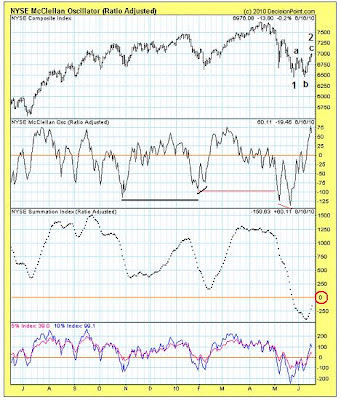$20 billion is a big number. It's "shock and awe" big. But is it just buying time, allowing today's still unfolding disaster an opportunity to drift from memory ... like Port-au-Prince? Benefiting, then, should be the "chisel" business and likely little else ... save, of course, the Mass Strike, which all the more is becoming a tinderbox ready to explode.
For in hearing little about wealth lost in the Gulf since April 20th — a sum likely dwarfing $20 billion — during what might have been the lamest 20 minutes a U.S. President ever has spent on national TV ... well, we probably are looking at a fast approaching shock and awe to the fragile edifice upon which the financial system sits ... making that $20 billion BP commitment look like so much chump change.
The Gulf disaster — but a more grotesque incident in the ongoing legacy of "creative destruction," imperial style, in the post-Bretton Woods era — comes at a time finding the nation still many trillions too leveraged. Today's stab at a "resolution" — like all other preceding "shock and awe" campaigns initiated over recent years — in all probability will prove yet another wet blanket venturing to delay a deluge whose yet wrought destruction unfortunately appears inevitable.
Were this the only looming collapse in physical asset values threatening to destroy a whole lot of leverage (and a great many financial firms, as well)! A picture's worth a thousand words, they say. So, have a look at coming Armageddon.

Among various technical measures presented here from time to time the McClellan Oscillator, first, is most emphatically recovering in conjunction with the market's stabilization over the past few weeks. Yet, foremost, this measure also is serving to confirm the view that, late-April marked a top from which further selling likely remains in store.
Not long ago I discussed technical differences the current moment presents in contrast to early-February. Both the NYSE McClellan Oscillator and Summation Index effectively highlight these, serving to challenge any assumption the current recovery might put the market in a similar position as mid-February.
Then, the market was poised to rise to a nominal new high, post-March '09 bottom. Now, however, immediate prospects are not nearly so positive.
You see this graphically, first, via markup I have drawn in the McClellan Oscillator panel. The market's decline from late-April peak resulted in the Oscillator falling below it previous trough reading. Contrarily, the market's decline from early-January peak saw the Oscillator hold above its previous trough reading.
Likewise, coinciding with the NYSE Composite's early-February bottom the McClellan Oscillator diverged from its late-January reading (indicating improving underlying technical conditions) ... whereas coinciding with the NYSE Composite's late-May bottom the McClellan Oscillator exceeded its early-May, flash crash reading (confirming underlying technical weakness).
Finally, we see the McClellan Summation Index presently confirming the market's weakened state by the fact its reading was moved into the negative as a result of the market's decline off late-April peak (and negative it remains despite the Oscillator's recovery). However, as you can see, the Summation Index did not pierce the negative anytime during the market's decline into early-February bottom.
Subtle though these technical differences (now versus February) might seem, they nevertheless are seen as significant, and entirely supportive of the Elliott wave count I have indicated above. Whether the a-b-c forming an "irregular flat" labeled wave 2 in fact completes the second wave down from late-April top remains to be seen.
All unknowns aside, there's a better than 50-50 chance wave 3 [down] — slated to challenge March '09 lows more nearly than most observers fear — is on the verge of unfolding over days immediately ahead.

* * * * *
© The Risk Averse Alert — Advocating a patient, disciplined approach to stock market investing. Overriding objective is limiting financial risk. Minimizing investment capital loss is a priority.
Analysis centers on the stock market's path of least resistance. Long-term, this drives a simple strategy for safely investing a 401(k) for maximum profit. Intermediate-term, investing with stock index tracking-ETFs (both their long and short varieties) is advanced. Short-term, stock index options occasionally offer extraordinary profit opportunities when the stock market is moving along its projected path.
Nothing is set in stone. Nor is the stock market's path of least resistance always known. More often than not, there are no stock index option positions recommended.
 There's an easy way to boost your investment discipline...
There's an easy way to boost your investment discipline...Get Real-Time Trade Notification!



















